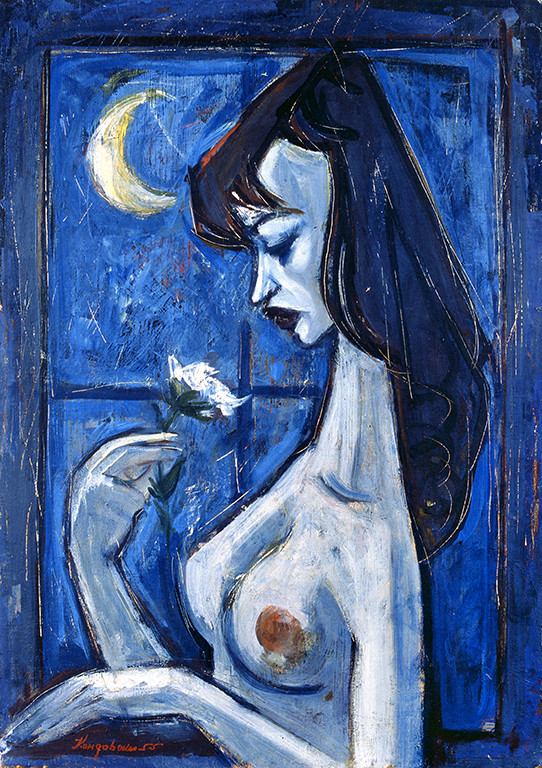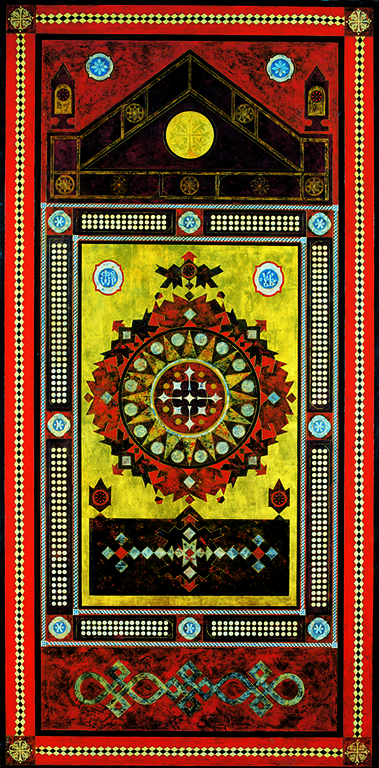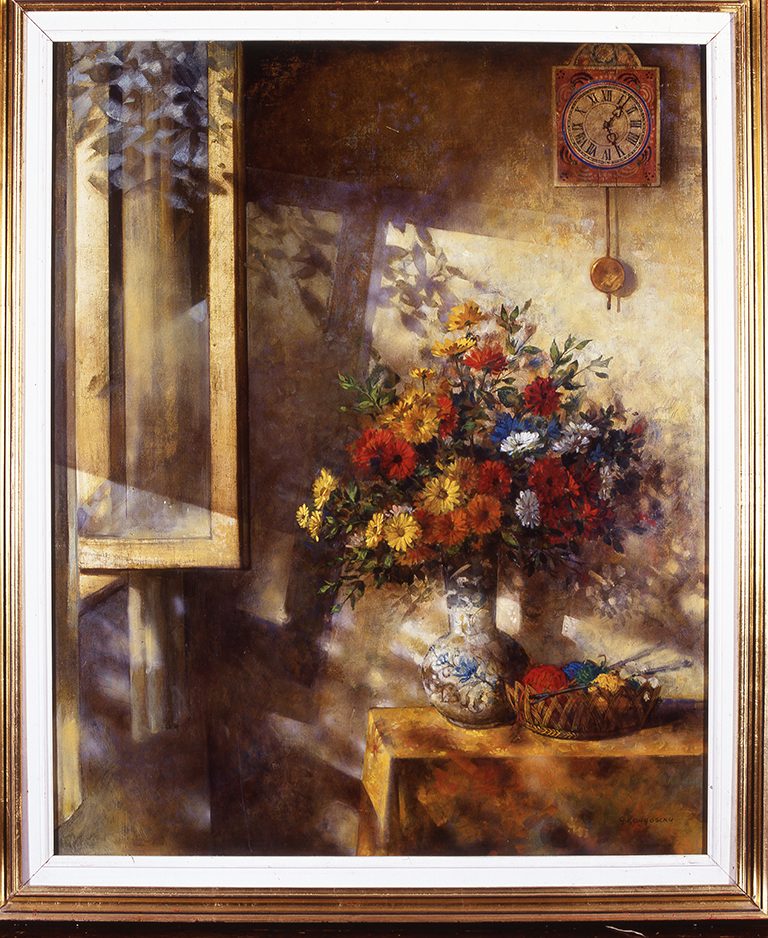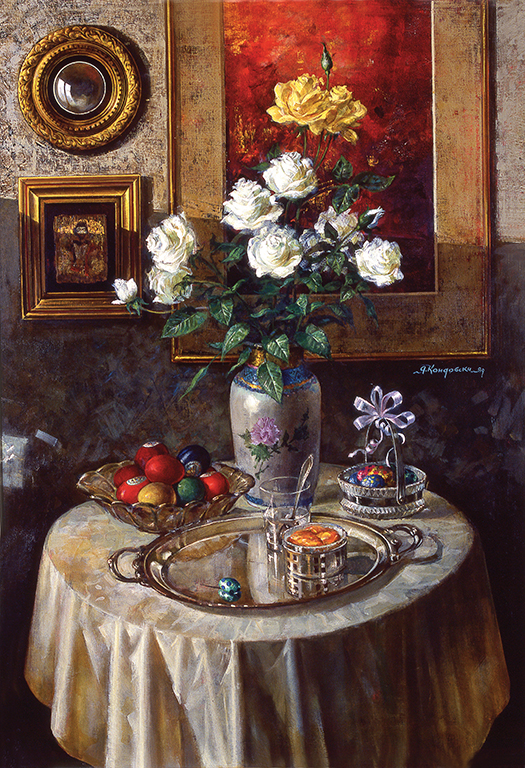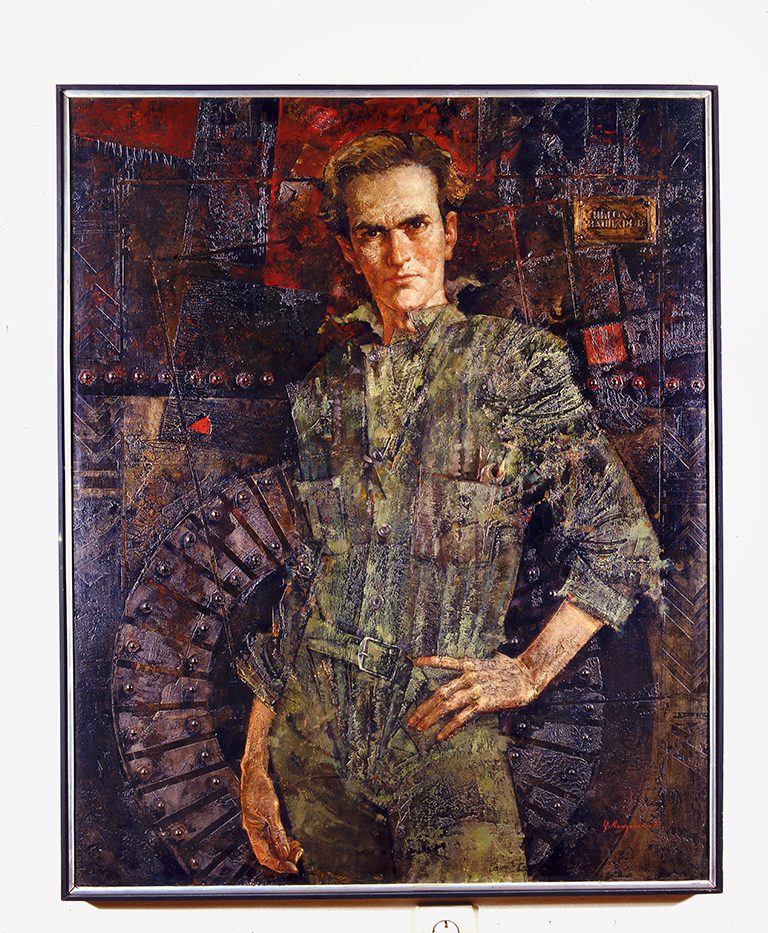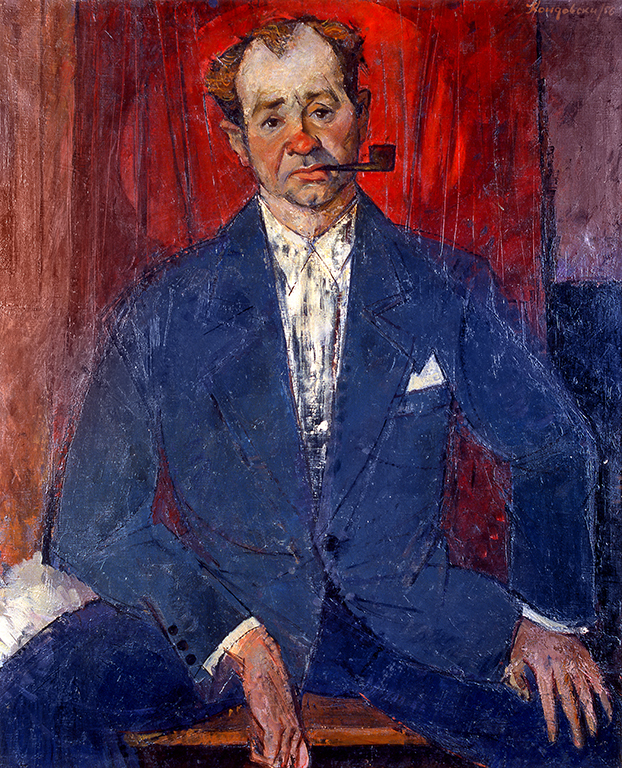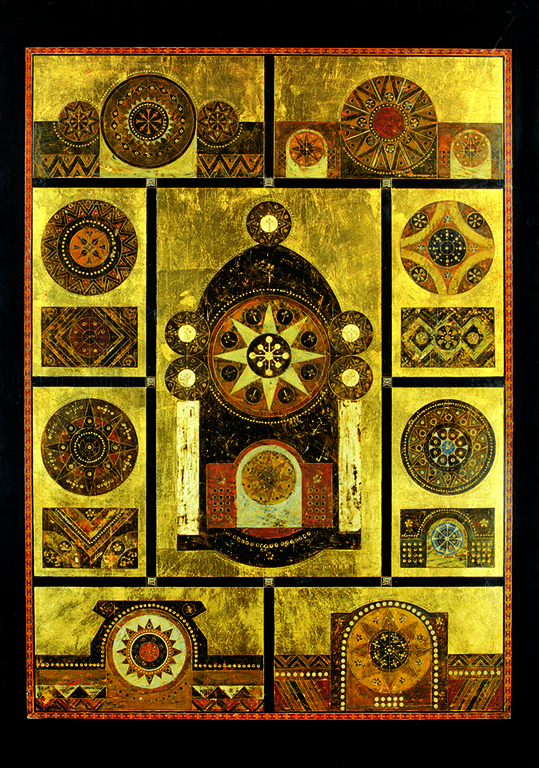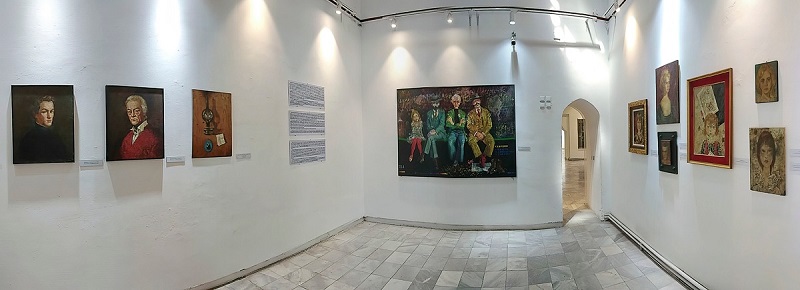Dimitar Kondovski (Prilep, 1927–Skopje, 1993) is undoubtedly one of the most important Macedonian artists. Controversial and charismatic as a person and as a creator, Kondovski left behind a creative opus whose dimensions are still inconceivable. His works mark the shining trace of a creative spirit that broke through new and hitherto unknown paths in art, paths that even today, on the map of contemporary Macedonian art, show the current directions of movement.
Dimitar Kondoski, from the very beginning of his artistic development, rapidly passed the path along which contemporary art has been moving for more than a century. During the 1950ies he went through post-academic realism with variations of styles (Martinoski, Modigliani, Picasso from the Blue Period, and, separately, Goya and Mane), through gradual geometrization and stylization of forms (through the post-Cubist experiment), fading of colour, breaking the image into strictly separated geometric surfaces, to constructive creation of forms. Analytical research quickly shifted to synthetic insights.
After a long process of purification of his artistic expression which can be understood as a period of re-examination of his own possibilities, in which, through stylization of forms and their gradual reduction to the level of a sign, in striving to give a visible form to the immutable structures of reality, of the timeless and eternal, of the primordial beauty that is beyond all separate forms, Dimitar Kondovski began his research on abstract art and absolute shaping.
Dimitar Kondovski created a series of paintings in which the complex compositions of signs and symbols taken from medieval art and folklore gradually began to dominate. Using tempera and gold, he reinforced the material plan of the painting on a wooden, primed panel, using a complex technological procedure of applying pigment, gold foil and filigree engraved marks, so that the works acquired formal-stylistic characteristics of icons. By 1972, this process ended with the definitive adoption of an established register of signs and symbols that would become a permanent feature of his work.
Kondovski continued his creative activity on two dynamic lines of development of fine arts. One determinant that shapes his work is the geometric abstraction which has its own complex genesis and which follows the Pythagorean-Platonic tradition expressing the concept of the universe arranged according to precise numerical relations to which the analogous proportionality of the work of art corresponds. This determinant would find its special expression in the geometric construction of his works, the use of complex mathematical calculations to set the basic composition, the use of the golden ratio (sectio aurea), the Fibonacci sequence, the geometric modules and the canons for determining the proportions, all the way to the absolute symmetry that expresses universal harmony.
The second determinant that directs Kondovski’s work is the painting of the sign and the symbol. In Kondovski’s works, the sign always has a high symbolic value. It not only points to the author’s inner world, but also reveals new perspectives on the universal, through the collective experience called forth from the abysses of time.
Since the end of the 1950ies, Kondovski had been developing the concept of figurative painting with an emphasis on geometric stylization of forms (influenced by folklore and icon painting). He moved towards an authentic synthesis between realism and abstraction by connecting the opposing components: the figurative and the abstract, the descriptive and the ornamental, the real and the fantastic. This synthesis is expressed through the geometrically precise setting of the composition, the two-dimensionally solved shapes most often broken into geometric segments, plastically modelled faces and hands processed with emphasized concentration and contrasting with the flat and ornamentally arranged clothes and background; placement of zones, usually two basic plans which he connects with the expansion of the ornamental decoration of the entire space of the painting. Symbolic elements are often woven into the ornament. The symbols and emblems, as well as the ornamental interweaving are in function of attributing or emphasizing some characteristic psychological aspects of the characters. Sometimes, the clothes are styled and richly decorated, thus reminiscent of Byzantine and Oriental ceremonial robes. The background is oversaturated with the multiplied ornament, and the faces and hands are the only elements that stand out in the foreground.
Kondovski developed the concept of author portrait and self-portrait, in parallel with research and experiments with geometric abstraction. From the beginning of the 1960ies, he worked on salon portraits in academic style and portraits made with a constructivist procedure that unites abstraction and figuration, through the ornament that connects them, where the portraits of saints also belong. Along with this mainstream in his work, there are branches that lead to the classical artistic expression, widely ranging from academic realism to figurative symbolism. All these currents and branches lead to one ultimate goal – an original synthesis of the art tradition and contemporary painting.
From the beginning of the 1960ies, Kondovski started painting on durable material, applying a complex technological procedure of preparation of the base, using tempera and gold and precious metals applications. The paintings he created during this period gradually acquired the meaning of sacred objects for him. Their construction is reminiscent of the silver-framed icons, the archaic triptychs that are closed to keep the secret from the uninitiated, the gilded royal doors of the iconostasis behind which the holy drama takes place, the richly decorated portals leading to the sacred space of the temple. On the gold or dark red base of these paintings, Kondovski inscribed signs and symbols, where every detail is processed with enamel excellence brought to perfection by the skill of the old masters (Polyptich, 1972-1978).
With a wide grip on the folklore treasury of Macedonia, Kondovski tried to catch and keep what has come to us from the inexhaustible sources of tradition in an extremely refined form – what shines like a jewel among the sedimentary layers of history crystallized under pressure of time. These fluorescent traces took him to the primordial spiritual layers where symbols that unite the world are created. Trying to convey onto his paintings the form in which the sacred appears – its imprint or seal – he created complex dynamic structures: mnestic engrams deeply ingrained in the collective consciousness. The subtly disturbed balance and the light scattered into countless reflections set in motion the elements of these structures.
The filigree ornament and the intricate line weave, the esoteric calligraphy and the mysterious symbols direct the viewer’s gaze to the depth of the image, to the secrets in it. What shines with such a strong glow hidden in the interweaving of lines and in the lavish ornament is the GOLDEN ROSE OF ALCHEMY.
Dimitar Kondovski took over the main themes from the aesthetic projection of the historical avant-garde and the modernist movement, building on a long tradition, which through medieval art, has its roots in ancient art and philosophy, simultaneously giving his own creative contribution to the survival of these ideas on the soil of Macedonia.
Dimitar Kondovski in his works used universal symbols that have their origin in the depths of the subconscious and the mysterious spaces of the imaginary. The imaginary, the mythical and the oneiric belong to an indefinite area, with indefinite borders, where the structures of all creativity are created – hence the original force of the works created by Dimitar Kondovski. He also used symbols taken from esotericism, alchemy and Kabbalah. The symbols, emblems, calligraphies and initials taken directly from medieval art are frequent, just as are the ornamental and decorative elements from folk art.
One of the characteristics of Dimitar Kondovski’s creative activity is the effort for his works to be in constant communication with the audience in order to realize their own prophetic function in the social community. The persistent insistence on connecting with the broadest popular strata and getting involved in popular culture undoubtedly corresponds to the ideas of the time, or rather appears as a reaction to the obvious discrepancy between political theory and practice, between ideals and reality, which creates a critical awareness in Kondovski regarding the place and the role of the artist in the social community. He believed that his works are intended for public buildings where they will be available to the widest circle of visitors. He gladly addressed the ignorant and the children. He understood his activity not only as a contemplative act, but as an action within the real social circumstances and the specific social environment.



